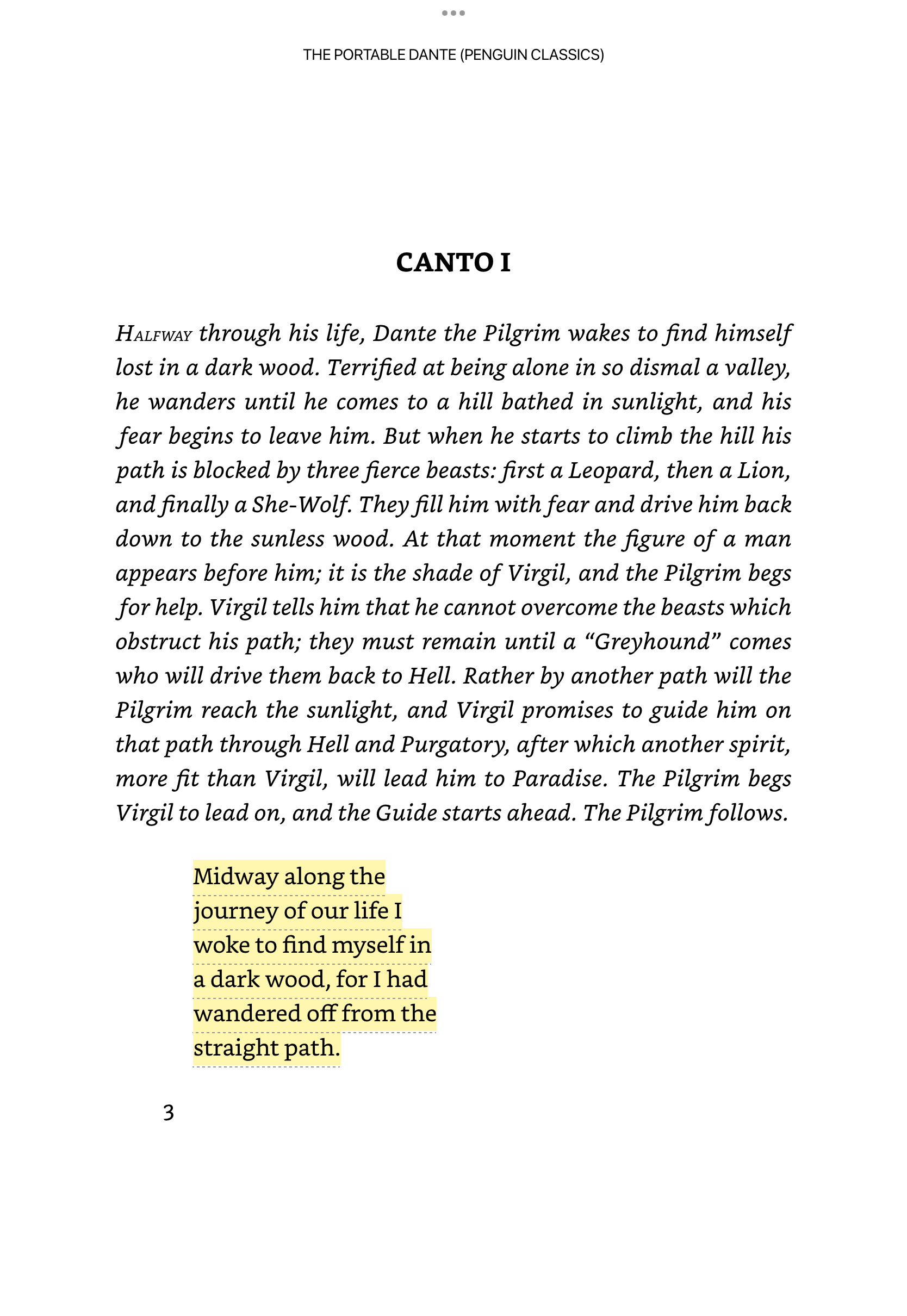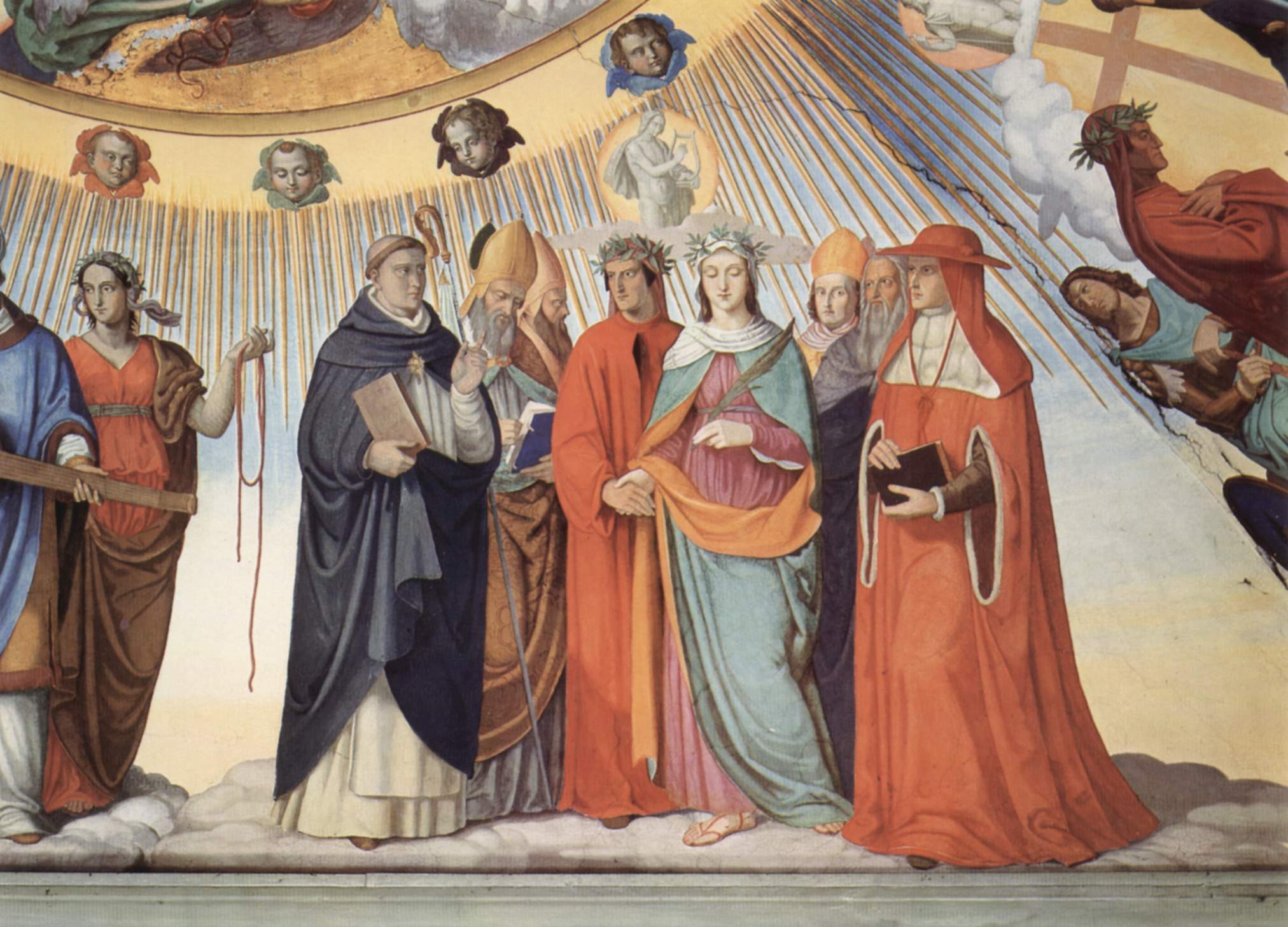The Divine Comedy is a long poem. Last week, I read the first part, Inferno, plus Dante’s prequel-of-sorts, La Vita Nuova. This week, I finished the two other parts of the Commedia: Purgatorio and Paradiso.
This is in keeping with Ted Gioia’s recommendations for reading the humanities in a year. As with previous weeks, I added a classic film to these suggestions. In keeping with the theme, I selected one about a journey of spiritual redemption.
Readings
Let’s start with a recap if you missed last week’s post: The Divine Comedy is one of the most famous poems in history; some people consider it the best ever written. Dante wrote it in the early 14th century, when he was 35.
This is significant because the poem is about how he overcame a mid-life crisis through a spiritual journey. Spiritual here means Catholic, as expected from a Medieval European. His journey takes him through Hell (Inferno), Purgatory (Purgatorio), and Paradise (Paradiso), the poem’s three sections.
It begins with Dante waking up to discover he’s lost his path. He comes to the foot of a mountain he must climb, but three symbolic beasts block his way. Guided by Virgil, Dante descends into the hell, a nine-circle funnel filled with “shades,” i.e., spirits punished for their sins.
Among the damned are Dante’s political and ecclesiastical foes. Their sins range from murder to betrayal. Each deeper circle reveals greater wickedness, culminating with Lucifer at Earth’s core. Virgil guides Dante up Lucifer’s back and out of Hell. This sets us up for the second part of the book, Purgatorio, where souls can redeem themselves.
Mirroring Inferno’s structure, Dante and Virgil ascend through seven cornices on their way up. Each is dedicated to atoning for specific sins by undergoing related tortures. For example, the gluttonous starve. Purgatory, too, is populated with famous people and Dante’s contemporaries.
When the pilgrim and his guide reach the top of mount Purgatory, Virgil disappears and is replaced with Beatrice, Dante’s platonic love and the object of his affections in La Vita Nuova. She’s descended from Heaven to guide him through the third and final part of the book, Paradiso.
Paradise, too, is structured in ascending levels. But rather than tangible places such as terraces or cornices, Beatrice guides Dante through the heavenly spheres: the Moon, Mars, Jupiter, etc., culminating in the Premium Mobile. This is the most “medieval” part of the book: the structure is pre-Copernican. The poem veers into abstraction, with everything flooded in dazzling light.
Paradise feels emptier than hell and purgatory. Dante meets fewer of his contemporaries. Instead, he comes across various saints, including Saint Thomas Aquinas and Saint Peter, who does a little jig around him. Eventually, Beatrice, too, is replaced with a final guide, the mystic Saint Bernard, who intercedes with the Virgin Mary so Dante can peek at God.
Here, the poem becomes almost completely abstract. Wisely, Dante explains that human language cannot accurately describe God:
Within the depthless deep and clear existence
of that abyss of light three circles shone—
three in color, one in circumference:the second from the first, rainbow from rainbow;
the third, an exhalation of pure fire
equally breathed forth by the other two.But oh how much my words miss my conception,
which is itself so far from what I saw
that to call it feeble would be rank deception!
The poem then ends abruptly. I wished to learn more about how Dante integrated this mystical experience into his life: how he overcome his crisis, how he changed his life, etc. He merely hints at internal change; we don’t learn how any of this plays out.
Audiovisual
Music: Bach’s Mass in B minor, one of the most famous and influential works of classical music. I’ve heard it many times, and still discover something new and moving every time I revisit it. (I’d love to attend a religious service where this is played live.)
Arts: Gioia recommended looking at Native American art, with a link to a Britannica article that provides good context. This was partly an inspiration for this week’s movie pick…
Cinema: Roland Joffe’s THE MISSION (1986), a religious film starring Robert De Niro, Jeremy Irons, Ray MacAnally, and Liam Neeson. It was nominated for several Academy Awards and was awarded the Palm D’Or at Cannes.
Set in 18th Century South America, the film explores the clash between Church and state interests centered in Jesuit missions in Paraguay. While the missions seek to convert the Guarani to Christianity, they threaten Portuguese and Spanish commercial interests, notably the slave trade.
The film’s heart is the relationship between Rodrigo (De Niro), a repentant mercenary, and Father Gabriel (Irons), who helps him atone for past sins. Working with the Guarani and other Jesuit priests, they develop a paradise on Earth. But when utopias meet realpolitik, utopias lose. Defying ecclesiastical orders to abandon the Guarani, Rodrigo fights while Gabriel relies on faith and love. Both meet tragic ends — such “have we made the world.”
Reflections
I first read The Divine Comedy fifteen years ago, when I was rounding the corner toward mid-life. I approached the poem with great expectations: while not suffering through a mid-life crisis, I expected to find guidance and enlightenment.
I was disappointed with that first reading. Inferno and Purgatorio felt petty. Dante wrote the poem from exile, and many of the damned are his earthly enemies. The last part, Paradiso, felt hopelessly medieval, with its Ptolemaic cosmology, endless saints and hosts, and numinous abstractions.
Revisiting the Comedy now made me appreciate it more. For one, I’m more open to metaphorical readings of texts created in a different context. While the endless parade of nemeses is still somewhat jarring, they’re meant to remind Dante (and by extension, us) of our failings. Dante’s ascension to the Primum Mobile is a metaphor for increasingly refined ways of being.
The point isn’t to avoid everlasting damnation; it’s living a better life here and now. We can debate whether indulging in the seven “deadly” sins — pride, envy, wrath, sloth, greed, gluttony, and lust — may damn us to hell, but they’ll sure as hell make our earthly lives worse.
The poem also presses a question it shares with THE MISSION: what is the proper relationship between our spiritual and moral cores and religious institutions? Dante hammers Church leadership, naming specific popes as sinners. He’s especially critical of simony, the selling of Church services — understandable, since he lived before the Reformation. But it’s still surprising to see in a medieval text.
For Dante — as for Rodrigo and Gabriel — our inner relationship with what’s right and true is more important than abiding by institutional strictures. His is a mystical (rather than social) spirituality. The question is, how does it influence our actions in the world?
Dante leaves it to our imagination. Rodrigo fights back. Gabriel leans into the teachings: love is all you need. All are dead now, but was one approach better than the other? Ideas define actions; an “honorable” action might increase suffering.
I suspect Dante would align with Gabriel, who sacrificed himself to demonstrate “the love that moves the sun and other stars.” But was his martyrdom necessary in the long term? It’s a tension we must accept — especially now, as the world plunges into yet another destructive conflict.
Notes on Note-taking
This week, I faced what might be a common challenge with poetry in ebooks: formatting issues.
Dante designed the Commedia’s structure with great care. I won’t get into it here, but suffice it to say that the poem has a very particular rhythm. The rhythm comes across in Italian — which I can read, although not fast enough to get through the whole poem in two weeks.
The question, for me, was which English translation to read. The one I read in 2010, by John Ciardi, emphasizes rhythm at the expense of a bit of clarity. To vary things up a bit, this time I got a translation by Mark Musa, which errs in the opposite direction.
Line breaks matter. Poetry is like Python, where whitespace is significant. But ebooks — especially older ones — sometimes have rendering bugs that affect line breaks. I found this to be an issue with both La Vita Nuova and Musa’s translation of the Commedia. (I used Kindle for both.)
Here’s the opening tercet in Ciardi:
Midway in our life’s journey, I went astray
from the straight road and woke to find myself
alone in a dark wood. How shall I say
And Musa:
Midway along the journey of our
life I woke to find myself in a dark
wood, for I had wandered off from
the straight path.
The Ciardi translation reads more cleanly as three lines. But the main issue for me was that layout in the Musa translation varied depending on whether the iPad was in landscape or portrait orientation. The quote above is the landscape version; here’s portrait:

Notice the whitespace to the right of the verse. Surely the lines could’ve been rendered more pleasantly. But why does this change at all? Shouldn’t one of them be authoritative?
What’s worse is that I had the sense that even in portrait (which is my preferred orientation when reading,) there seemed to be a change around halfway through the text. I haven’t been able to replicate it, but I could swear that line breaks changed at some point.
I’ve always found verse harder (and slower) to read than prose, and this change didn’t help. It was jarring enough that I returned to Cialdi for the last third or so of the poem. I don’t know how much more poetry lies ahead in the course, but this might be a genre better served on paper.
Up Next
At last, Shakespeare! This will be the first of two weeks we’ll devote to the Bard. Gioia recommends Hamlet, Macbeth, and King Lear. I’ve read the first two, but not the last. Even though I have all of Shakespeare’s works in ebook form, I’ll use a dedicated app for this part of the course. I’m excited!
Again, there’s a YouTube playlist for the videos I’m sharing here. I’m also sharing these posts via Substack if you’d like to subscribe and comment. See you next week!
